Corvettes of the Visby project (Sweden)
Since the late eighties, the Swedish shipbuilding industry has been working on the project of the experimental ship Smyge. During the development of this vessel, some new ideas and technologies were introduced. Later, part of the know-how of this project was used to create new ships, primarily Visby-type corvettes.
Actually the development of promising corvettes started in the first half of the nineties. Initially, the fleet command ordered the creation of two new projects under the symbols YSM (Ytstridsfartyg Mindre - "Small Warship") and YSS (Ytstridsfartyg Större - "Big Warship"). In the future, the country's leadership ordered a reduction in military spending, which resulted in the rejection of two separate projects. Different ideas and ideas for two projects decided to unite in one. As a result, specialists from Kockums, with the assistance of the fleet and the Royal Institute of Technology, developed the YS2000 project (Ytstridsfartyg 2000 - “The 2000 Battle Ship of the Year”).
Combining projects YSM and YSS affected the appearance of the new YS2000. It was assumed that the "Ship 2000 of the Year" will be able to solve a wide range of different tasks that were previously planned to be distributed between ships of two types. Thus, a promising ship had to destroy surface and coastal targets, search for and destroy submarines, conduct a search for sea mines, escort convoys, etc. One of the consequences of this were serious differences in the composition of the equipment and weapons of serial ships.
The decision to build a new corvettes project YS2000 was taken in 1995 year. In mid-October, Kockums received an order for the first two ships of the series. In accordance with the first contract, the shipyard was to build and transfer to the fleet two ships, HSwMS Visby (K31) and HSwMS Helsingborg (K32). In December, the 96 fleet ordered two more ships named HSwMS Härnösand (K33) and HSwMS Nyköping (K34). The third contract of August 1999 of the year implied the construction of two ships, but was soon shortened. The ship building program was too expensive, which was why the military department was forced to abandon the sixth corvette. The fifth ship, in turn, received the name HSwMS Karlstad (K35).
It should be noted that the command of the Swedish Navy did not immediately decide to reduce the series. In October, 2001 was made only a preliminary decision. The military reserved the right to re-order the corvette until the autumn of 2003, but did not use it. According to reports, the construction of the five ships cost the Swedish treasury 0,9 billion US dollars.
The lead ship of the series, the Visby, was laid at the Kockums factory in Karlsruhn in February 1995. The construction of the corvette was delayed for several years. Due to the use of the mass of new technologies and some problems of a different nature, the ship was launched only in the middle of the 2000 year. Further completion was also accompanied by serious difficulties. There were problems with the supply of various equipment and weapons. As a result, part of the test ship passed with incomplete equipment. For example, in 2008, it was reported that the HSwMS Visby corvette had not yet received all the weapons and was equipped with only a cannon.
The second and third ships of the project were laid in the summer and winter of 1997. In the middle of 98, the construction of the Nyköping ship began, and the Karlstad was laid at the very end of 1999. The construction of the sixth ship did not begin, but part of the equipment for it was ordered. Subsequently, this equipment was used in the construction of the shore simulator for the crew.
A characteristic feature of the Visby project became the so-called. version. Since the ships did not immediately receive all the necessary equipment and weapons, classification was applied with versions differing from each other in numbers. So, in the middle of December 2009, the contracting company handed over to the fleet the first two completed ships, HSwMS Helsingborg and HSwMS Härnösand. At this point, the ships received all the necessary equipment and weapons, although only an artillery unit was tested. The term “4 version” was used to denote this configuration.
In 2012, it became known about the development of the so-called. 5 versions. This version of the project is characterized by an updated composition of the equipment and some design changes. During the upgrade to this version of the ship's hull receives some new parts, also installed new equipment to search for mines and anti-ship missiles. In addition, the 5 version of the project allows the ship to carry a helicopter. The first to upgrade version 5 went Corvette "Visby".
One of the main goals of the Visby project was to reduce the visibility of ships for enemy surveillance equipment. The most noticeable consequence of this is the characteristic appearance of the corvettes. All the necessary components and assemblies are located inside the case, consisting of a set of flat panels. Also, to reduce visibility reduced superstructure, which is a block consisting of two main parts. In front of the superstructure, having the shape of a truncated pyramid, there is a bridge, in the back - an open area with missile launchers.
The main material of the ship hull is a composite material based on polyvinyl chloride with carbon fiber reinforcement. Such material has high strength and rigidity with low weight, and also almost does not reflect electromagnetic radiation. From composites is performed as the hull of the ship, and its superstructure and other elements. In some sources it is mentioned that the used hull can significantly reduce the range of possible detection of the ship. So, with a calm sea, radar stations notice it from a distance of no more than 20-22 km. With the use of electronic warfare systems, the enemy's detection range is reduced to 10-11 km. At the same time, the range of detection systems of the corvette itself remains unchanged.
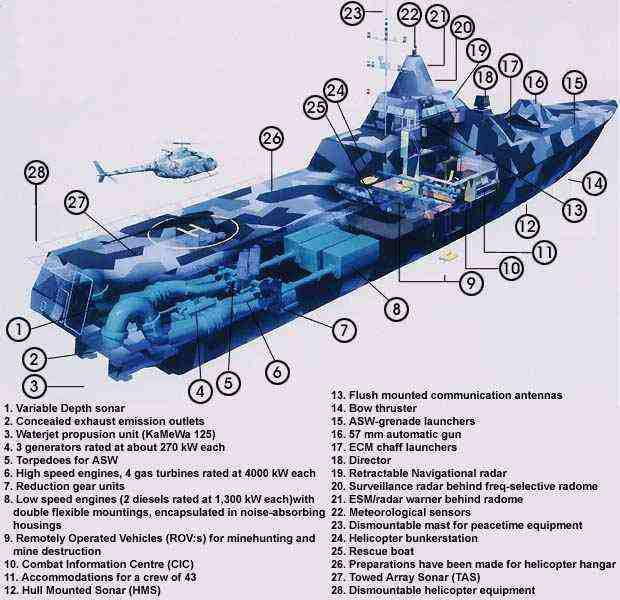
Ship HSwMS Nyköping (K34) in the sea. Photo Arms-expo.ru
The ships "Visby" have a length of 72,7 m, a maximum width of 10,4 m and a draft at the level of 2,4 m. Displacement is only 640 t. Such lightness of construction is provided, first of all, with the materials used. When using metal hull and superstructure, the displacement of the ship could have been significantly greater.
In the stern of the hull, under the helipad, are units of the power plant class CODOG. To improve the performance of the power plant used diesel and gas turbine engines operating alternately. For operation with less power and less fuel consumption, the power plant uses two MTU Friedrichshafen 16V2000 N90 diesel engines with an 1,3 MW power. If necessary, the crew can start four Honeywell TF50A gas turbine engines with an 4 MW power. Three electric generators for each 270 kW are connected to the engines. The engines with the help of gearboxes are connected to two shafts and ensure the operation of two jet propulsion devices developed by Kamewa. This type of propulsion was proposed to be used to improve the driving characteristics of ships.
Due to the sufficiently large power supply, the Visby type corvettes are capable of speeds of at least 35 nodes (when using gas turbine engines). At an economic speed of 15 knots, the cruising range is at the level of 2500 nautical miles.
Visby ships are equipped with the Certis C3 combat information and control system, most of the tasks being performed by two main subsystems: the MAST information support system and the Saab Systems 9LV Mk 3E fire control system. Communication and control systems are designed in such a way that the corvettes can operate autonomously, without constantly maintaining communication with other ships. If necessary, data can be received, but the ship's own emitters may not be used. To suppress enemy’s electronic equipment, ships should use Rheinmetall TKWA / MASS electronic warfare systems.
To meet the challenges of anti-submarine defense, Visby corvettes can carry a range of sonar tools. The project provides for the use of a hydro-acoustic station inside the hull and a towed system of a similar purpose.

The structure of the ship. Figure Alternathistory.org.ua
Before the superstructure, an artillery installation is placed on the deck in a casing of a characteristic complex shape. Inside the casing is a Bofors 57 Mk 3 caliber 57 mm. On the gun installation, the sensors of the SaabTech CEROS 200 fire control system are mounted: a radar station and an optical-electronic system. The gun can fire at a rate of up to 220 shots per minute. Ammunition includes various projectiles, including fragmentation ammunition with a programmable fuse. Such projectiles make it possible to “cover” the target with the maximum possible number of fragments.
A curious feature of the artillery installation is the method of transporting the gun in the stowed position. To reduce the visibility of the entire ship, the gun barrel is lowered into the longitudinal window of the casing and closed with movable flaps. Due to this, no units do not protrude beyond the casing and do not increase the visibility of the ship for radar systems.
Under the platform behind the bridge it was proposed to place launchers of anti-aircraft missiles. For protection from an air attack, it was planned to use the Denel Umkonto air defense system, but later they turned out to be from this. Even after several upgrades, the Visby Corvettes do not have anti-aircraft missiles. Some materials on these ships mention the possibility of installing a small-caliber anti-aircraft artillery mount on a movable base in the stern. In the firing position, it should be extended above the deck and lowered back to the marching position. Similar systems are also not used on serial ships.
Behind the superstructure are the launchers of anti-ship missiles Saab Bofors RBS-15 Mk 2. Ammunition Corvette includes eight such missiles. With this weapons the ship can destroy surface targets at ranges up to 250 km.
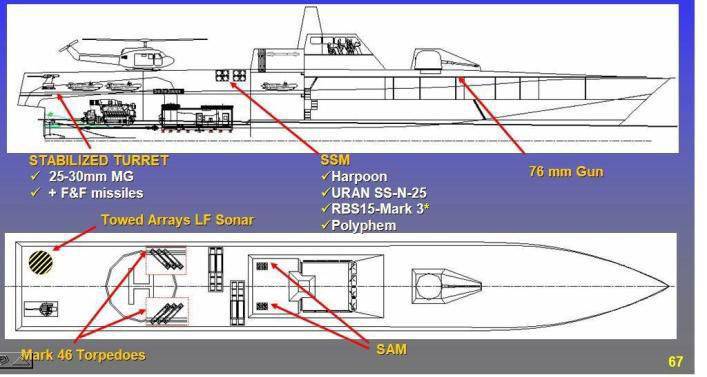
Unrealized complete weapons deployment scheme. Figure Alternathistory.org.ua
To destroy the submarines are encouraged to use jet bombs and torpedoes. Alecto X-Bomb caliber 127 mm are located in the bow of the ship, near the artillery installation. Four torpedo tubes for the torpedoes TP 43 or TP 45 are located in the rear part of the hull, in special lansporta.
The Corvettes of the Visby project, at the request of the military, must search and destroy not only submarines, but also sea mines. To combat these weapons, it was proposed to equip ships with a number of special equipment. The main system of the anti-mine complex is remotely controlled underwater vehicles Bofors Double Eagle. The structure of this system consists of two underwater vehicles, one of which is equipped with a set of sensors, and the second with means of neutralizing mines. Due to this, the operator of the complex can find dangerous objects, and then neutralize them, cutting minrepry or undermining on the spot.
The stern of the ships is a landing pad for helicopters. Aviation the corvette group consists of one Augusta A109 helicopter or other similar machine. The helicopter can carry sonar equipment, missile and bomb weapons, as well as be used in search and rescue operations. Some ships of the project are equipped with a helicopter hangar under the deck.
Five Visby project corvettes have some differences from each other. For some reason, the ships received a different composition of equipment and weapons. Thus, the first four corvettes were initially considered as anti-submarine ships with the ability to search for and destroy mines. Only the fifth and sixth ships of the series should attack enemy ships. In the future, it was decided to change the composition of the armament of the ships, ensuring the solution of various tasks, which is why a new weapon appeared on some corvettes.
For example, at the moment the lead ship HSwMS Visby is equipped with an artillery installation, torpedo tubes, anti-ship missiles and a jet bomb. In this configuration, it refers to the "5 version". The ship HSwMS Helsingborg has a similar weapon system, but it is not equipped with torpedo tubes. The same weapons are used on the third ship of the series, HSwMS Härnösand. In the end, it was decided to upgrade all the ships in accordance with the project "version of 5", but basically it affected only electronic equipment.
The five Visby corvettes were transferred to the 3 and 4 in the naval fleets of the Swedish Navy. Currently, the lead ship serves in the 4 fleet, the rest belong to the 3. To test new ships in the fleet, special connections were created under the name PTK Visby. Formally, they belonged to the flotilla, but submitted directly to the command of the Navy. The task of these units was to test and test the operation of new ships before starting full service.
To date, all five Visby corvettes have been transferred to the fleet and have begun a full service. The first two ships began to serve in December 2009. The remaining corvettes became full-fledged combat units of the Navy only in September 2015. Over the past few years, all ships have been upgraded to the "5 version" and, based on the results of this update, have been officially accepted into the naval forces.
For several years of service, Corbytes of the Visby type several times took part in various exercises, during which they solved antisubmarine defense tasks, searched for mines and carried out other missions. For obvious reasons, such ships have never participated in real hostilities. Because of this, their effectiveness can be assessed only on the basis of the results of training events, but not exploitation in conditions of real conflict.
Previously, there was information about the desire of the Kockums company to offer Visby corvettes to foreign customers. To this end, several new versions of the project were developed, differing from the basic version in size, equipment composition and other characteristics. Published data on the possibility of building the four versions of the ship Visby Family.
The closest version to the original was the Visby Export version, which differed from the Swedish ships with a slightly smaller size and equipment, selected in accordance with the wishes of the customer. The main characteristics of the ship remained at the level of indicators of basic corvettes.
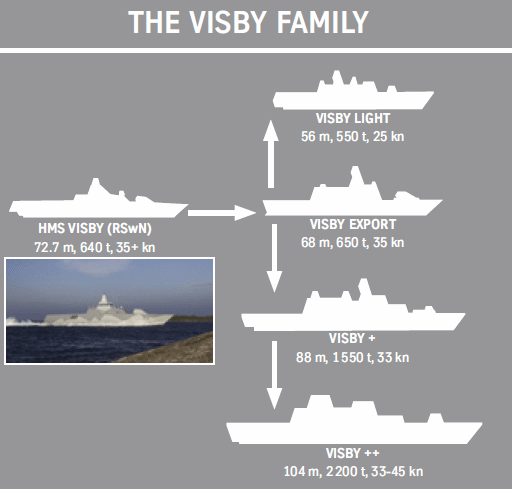
Ships of the Visby Family. Figure Globalsecurity.org
Also offered option Visby Light ("Light"). Such a ship should have a length of about 55-56 m and a displacement of no more than 550 t. Other characteristics, as well as the composition of weapons and equipment, should have been reduced accordingly.
The Visby + project implied the construction of ships with a length of about 90 m and a displacement above 1500 t. The Visby ++ project was also worked out. Such a ship could have a length of more than 100 m and a displacement of the order of 2200 t. According to published materials, it was possible to maintain the driving characteristics of the base ship.
As far as is known, not a single foreign customer showed interest in the export versions of the Visby project. Despite some interesting features, such projects did not find the customer and remained on paper. The only operator of Visby ships remains the naval forces of Sweden. It is hardly to be expected that the list of owners of such corvettes will be added in the near future.
Despite the small number of built ships, the Visby project is of great interest. Swedish shipbuilders were able to solve a number of important problems concerning the expansion of the range of tasks performed, ensuring minimal visibility for enemy detection equipment, etc. The result was the appearance of ships with non-standard appearance and promising characteristics.
The construction, testing and modernization of five ships of the Visby project has been dragged out for almost two decades. From the laying of the first ship to the commissioning of the last three a little over 20 years passed. During this time, the Swedish experts were able to solve the tasks and correct the identified shortcomings. As a result, the Swedish Navy became the first operator of large warships built using stealth technology. Due to this, despite its small size, the Swedish fleet can claim to be one of the most modern in the world.
On the materials of the sites:
http://globalsecurity.org/
http://naval-technology.com/
http://janes.com/
http://arms-expo.ru/
http://flotprom.ru/
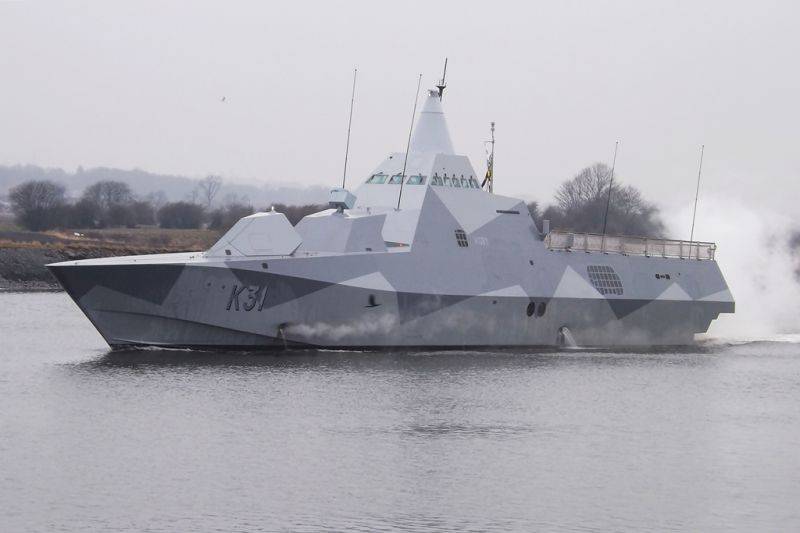
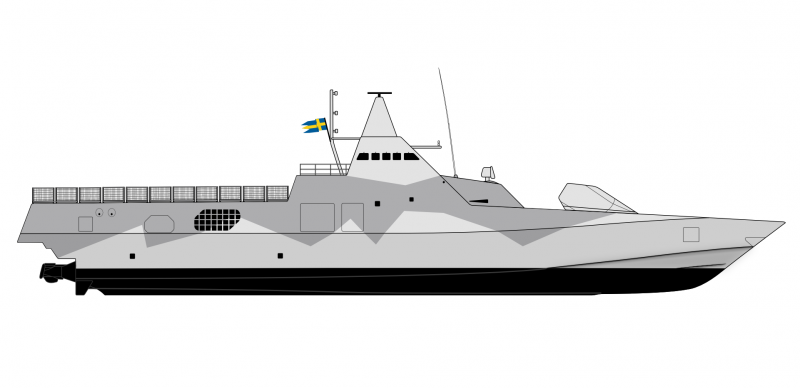
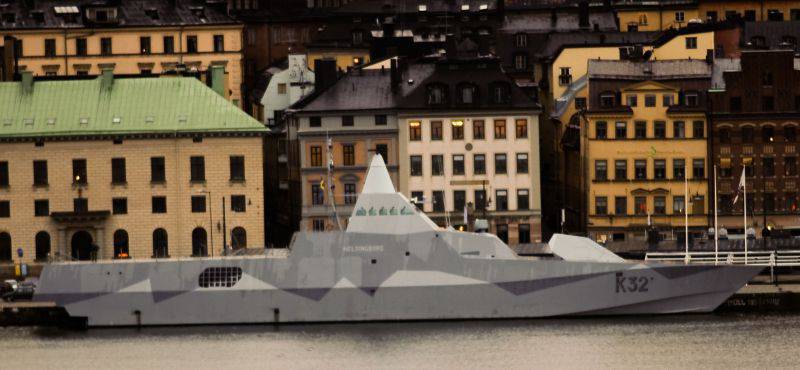
Information